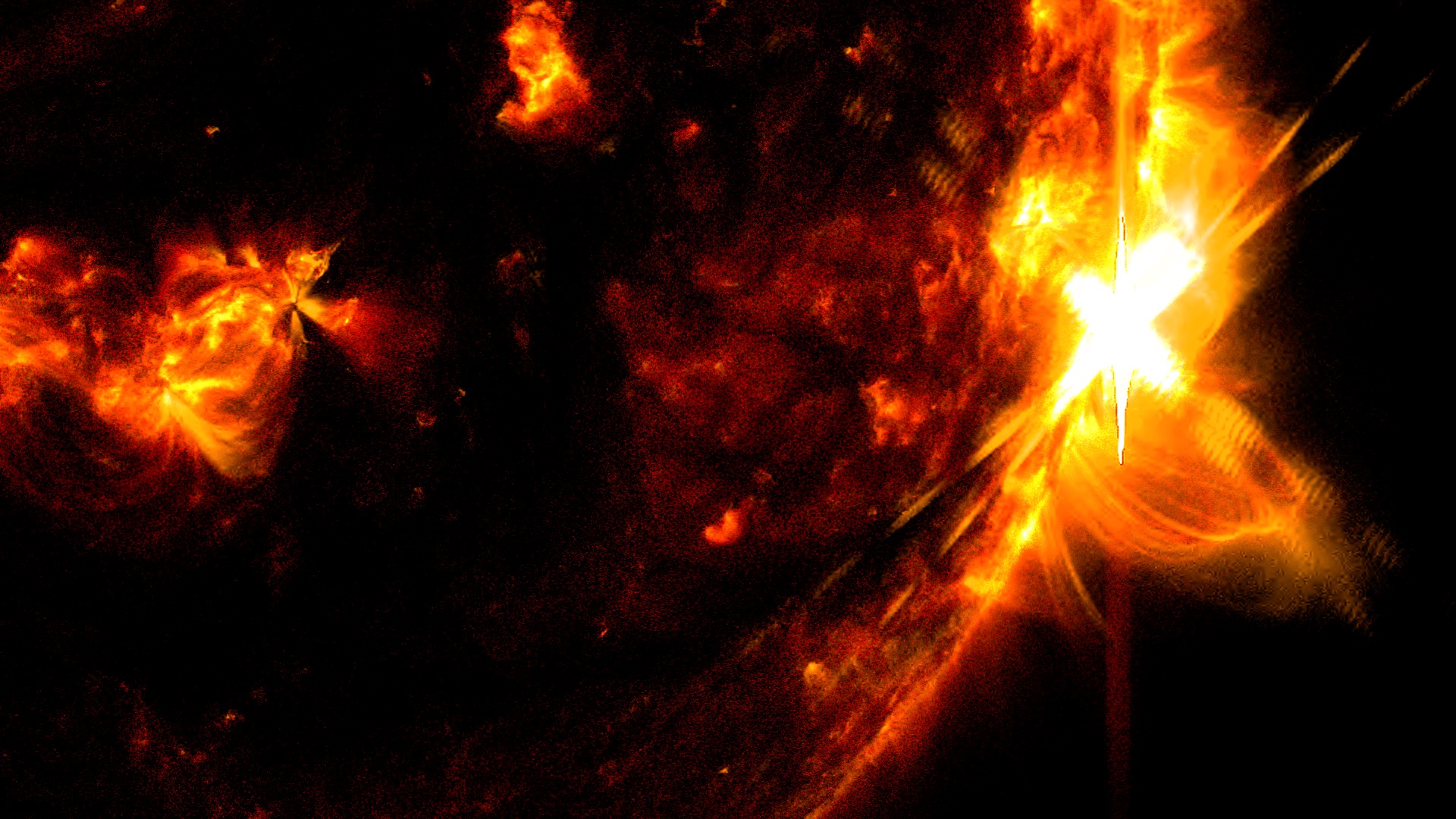Continued Strong Solar Flare Activity: May 10-14, 2024

NASA’s Solar Dynamics Observatory captured images of the two solar flares on May 10 and May 11, 2024. The flares are classified as X5.8 and X1.5-class flares, respectively. The image shows a subset of extreme ultraviolet light that highlights the extremely hot material in flares created from a mixture of SDO’s AIA 193, 171 and 131 channels. Available with EDT and UTC time labels as well as unlabeled.
Credit: NASA/SDO

NASA’s Solar Dynamics Observatory captured this image of an X1.5 solar flare peaking at 7:44 am EDT on May 11, 2024. The image shows a subset of extreme ultraviolet light that highlights the extremely hot material in flares created from a mixture of SDO’s AIA 193, 171 and 131 channels.
Credit: NASA/SDO

NASA’s Solar Dynamics Observatory captured this image of an X5.8 solar flare peaking at 9:23 pm EDT on May 10, 2024. The image shows a subset of extreme ultraviolet light that highlights the extremely hot material in flares created from a mixture of SDO’s AIA 193, 171 and 131 channels.
Credit: NASA/SDO

Cropped version of the above.
Credit: NASA/SDO

NASA’s Solar Dynamics Observatory captured this image of an X5.8 solar flare peaking at 9:23 pm EDT on May 10, 2024. The image shows SDO's 131 channel, a subset of extreme ultraviolet light that highlights the extremely hot material in flares.
Credit: NASA/SDO

NASA’s Solar Dynamics Observatory captured this image of an X5.8 solar flare peaking at 9:23 pm EDT on May 10, 2024. The image shows SDO's 193 channel, a subset of extreme ultraviolet light.
Credit: NASA/SDO

NASA’s Solar Dynamics Observatory captured this image of an X1.5 solar flare peaking at 7:44 am EDT on May 11, 2024. The image shows SDO's 131 channel, a subset of extreme ultraviolet light that highlights the extremely hot material in flares.
Credit: NASA/SDO

NASA’s Solar Dynamics Observatory captured images of the two solar flares on May 13 and May 14, 2024. The flares are classified as X1.7 and X1.2-class flares, respectively. The image shows a subset of extreme ultraviolet light that highlights the extremely hot material in flares created from a mixture of SDO’s AIA171 and 131 channels. Available with EDT and UTC time labels as well as unlabeled.
Credit: NASA/SDO

NASA’s Solar Dynamics Observatory captured this image of an X1.7 solar flare peaking at 10:09 p.m. EDT on May 13, 2024. The image shows a subset of extreme ultraviolet light that highlights the extremely hot material in flares created from a mixture of SDO’s AIA 171 and 131 channels.
Credit: NASA/SDO

Cropped version of the above.
Credit: NASA/SDO
NASA’s Solar Dynamics Observatory captured this imagery of an X1.7 solar flare peaking at 10:09 p.m. EDT on May 13, 2024. The clip covers 9:00 to 11:48 p.m. and shows a subset of extreme ultraviolet light that highlights the extremely hot material in flares created from a mixture of SDO’s AIA 171 and 131 channels.
Credit: NASA/SDO
NASA’s Solar Dynamics Observatory captured this imagery of an X1.7 solar flare peaking at 10:09 p.m. EDT on May 13, 2024. The clip covers 9:00 to 11:48 p.m. and shows 131 angstrom light, a subset of extreme ultraviolet light that highlights the extremely hot material in flares.
Credit: NASA/SDO
NASA’s Solar Dynamics Observatory captured this imagery of an X1.7 solar flare peaking at 10:09 p.m. EDT on May 13, 2024. The clip covers 9:00 to 11:48 p.m. and shows 171 angstrom light, a subset of extreme ultraviolet light that highlights hot loops of plasma in the Sun's corona.
Credit: NASA/SDO

NASA’s Solar Dynamics Observatory captured this image of an X1.2 solar flare peaking at 8:55 a.m. EDT on May 14, 2024. The image shows a subset of extreme ultraviolet light that highlights the extremely hot material in flares created from a mixture of SDO’s AIA 171 and 131 channels.
Credit: NASA/SDO

NASA’s Solar Dynamics Observatory captured this image of an X1.2 solar flare peaking at 8:55 a.m. EDT on May 14, 2024. The image shows 131 angstrom light, a subset of extreme ultraviolet light that highlights the extremely hot material in flares.
Credit: NASA/SDO
For More Information

Credits
Please give credit for this item to:
NASA's Goddard Space Flight Center. However, individual items should be credited as indicated above.
-
Producer
- Scott Wiessinger (KBR Wyle Services, LLC)
-
Science writer
- Miles S. Hatfield (Telophase)
Release date
This page was originally published on Saturday, May 11, 2024.
This page was last updated on Tuesday, May 14, 2024 at 11:49 AM EDT.


